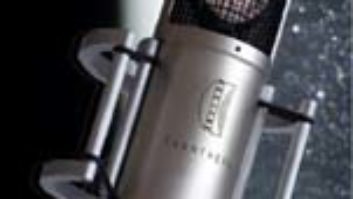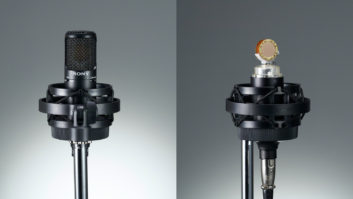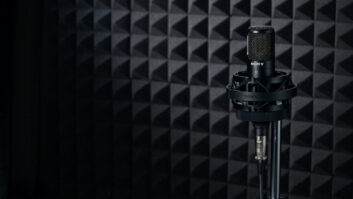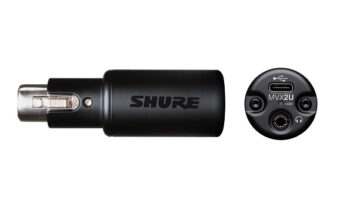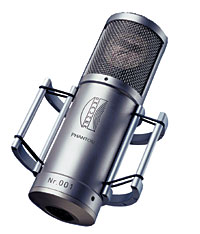
Brauner has a reputation for building ultratransparent tube mics
with very low self-noise and high sensitivity. Recently, the
Germany-based manufacturer shifted direction with its first solid-state
mic, the Phantom C ($1,750 list) cardioidcondenser.
Despite its moderate price (relative to that of other Brauner mics),
it’s obvious that no expense was spared in the construction of the
Phantom C. Its cylindrical brass body (the same used in the Brauner
Valvet and Valvet Voice microphones) weighs a hefty 19.4 ounces. Inside
the head grille is a 1-inch-diameter, 6-micron-thick diaphragm.
Included with the mic are a sturdy shock-mount and foam-lined aluminum
carrying case. The mic and its accessories convey outstanding build
quality.
The only corners cut are in the mic’s feature set. The Phantom C is
cardioid-only and lacks any sort of pad or low-cut filter. Considering
the mic’s robust 28mv/Pa sensitivity, the omission of a pad can be
problematic when miking loud instruments with a padless preamp. But the
mic’s high output, hushed 9dBA self-noise and stout 142dB maximum SPL (for 0.3% THD) ratings guarantee a
stellar dynamic range and barely existent noise floor at
the mic’s output. The Phantom C’s response is stated to be 20 to 22k Hz
with no ± tolerances given. Current draw is specified to be a
hefty 4 ma.
The Phantom C’s intricate shock-mount is more than just a
standard-issue gizmo. A pair of semicircular aluminum
rings—stabilized by three vertical struts—is suspended by
beefy elastic bands inside a pair of larger, similarly constructed
rings. The mount can rotate both vertically and horizontally through
almost 180 degrees of arc. A clever ratcheting mechanism on the mount’s
stand adapter locks the mount in place.
PHANTOM C IN SESSION
Recording male lead vocals, I compared the Phantom C to my Neumann U87A
using my Millennia HV-3D 8-channel preamp and Apogee Rosetta 96 A/D in
the recording chain. The Phantom C delivered far more nuance and depth
than the U87A, lending a striking sense of realism to the track. While
the high end was also more articulate on the track recorded with the
Phantom C, it nevertheless sounded natural and unhyped. Both mics
reproduced roughly the same amount of bottom end overall, but the
Phantom C’s bass response was smoother, exhibiting less of a hump in
the upper bass. I won’t give away my U87A anytime soon — it’s an
outstanding mic with a unique character that flatters in many
applications — but I was floored by how much depth and nuance the
less-expensive Phantom C reproduced.
Results were equally impressive on female vocals miked at seven
inches from the Phantom C and recorded through the Millennia HV-3D/8
and Rosetta 96. The mic delivered enough bottom to round out the
singer’s timbre, and highs were detailed without sounding sibilant. The
Phantom C lent beautiful midrange resolution without sounding
“hard” or glaring. Once again, the depth of the recording
was outstanding.
Next up was a seven-piece Latin band. I used the Phantom C to record
timbales, which were mounted above the floor tom in a trap set. (The
drummer played the timbales and traps simultaneously.) I placed the
Phantom C behind and above the drummer’s right shoulder, 2½ feet
above the timbales and angled 45 degrees downward to face them. The
sound was spectacular, needing only moderate boost in the top octave to
make the timbales cut through a dense arrangement. I missed having a
mic pad for this application, however, as I used the Phantom C with the
Millennia HV-3D/8, which has no pads and produces a minimum of 8dB
gain, and a MOTU HD192 I/O box, which has no calibration trims. With
this setup, I couldn’t avoid hitting 0 dBFS on some peaks in Digital
Peformer. The track sounded fine, though, as there was no audible
capsule or other distortion.
On another session, I used the Phantom C to record a cajón, a
large wooden cube with a circular cutout that is played with a
technique similar to how congas are played, except the musician sits on
the box. Although the spectral balance was excellent, the Phantom C
didn’t have the lightning-fast transient response I was looking for. My
small-diaphragm DPA 4011 was a better choice. The Phantom C was also
not the best choice to record acoustic guitar arpeggios, as the mic
reproduced a bit too much bottom end and was not quite fast enough to
capture the intricate detail that I was after. Considering the mic is
tuned for recording vocals, this was no surprise.
WRAPPING IT UP
The Phantom C is an outstanding vocal mic offering excellent results in
some instrumental applications. Of all the subjective qualities a mic
might bring to a recording, depth is the most elusive. Brauner provided
the Phantom C’s sonic signature with a sense of realism usually only
heard in far more expensive microphones. The Phantom C sounds
transparent yet big, articulate yet smooth. Add high sensitivity, low
noise, wide dynamic range and affordable pricing to the mix, and the
Phantom C is a winner.
Brauner, dist. by Transamerica Audio Group, www.transaudiogroup.com

